I have this dot code which I use in R's diagrammeR-package:
grViz("digraph {
graph [layout = neato,
overlap = false,
outputorder = edgesfirst]
node [shape = rectangle]
# Error Certainty
crt1e[pos = '11.1, 15!', label = '0.11', width = 0.9, shape = none]
crt2e[pos = '12.3, 15!', label = '0.11', width = 0.9, shape = none]
crt3e[pos = '13.5, 15!', label = '0.11', width = 0.9, shape = none]
crt4e[pos = '14.7, 15!', label = '0.11', width = 0.9, shape = none]
# Certainty
crt1 [pos = '11.1, 14!', label = 'crt1', width = 0.9]
crt2 [pos = '12.3, 14!', label = 'crt2', width = 0.9]
crt3 [pos = '13.5, 14!', label = 'crt3', width = 0.9]
crt4 [pos = '14.7, 14!', label = 'crt4', width = 0.9]
# Latent Certainty
crt [pos = '12.9, 12!', label = 'crt', width = 1.3, shape = circle]
# Path Certainty
crt->crt1 [label = '0.6']
crt->crt2 [label = '0.6']
crt->crt3 [label = '0.6']
crt->crt4 [label = '0.6']
# Covariance
crt3:n->crt4:n[label = '0.7', dir = both, constraint = false]
# Error Path
crt1e->crt1
crt2e->crt2
crt3e->crt3
crt4e->crt4
}")
This looks exactly as I want it to, except for the edge between crt3 and crt4. I want this edge to be curved upwards. I also need to control position of each node manually. How can I achieve both at the same time?
I have tried to use the "dot" layout. This creates a nicely curved edge for crt3->crt4 but it does not support fixed positions.
Adding a dummy node between crt3 and crt4 and using splines = true messed up the distances between all nodes in my diagram.
EDIT
I tried the suggested solution in a bigger context. Here, the edges are drawn over each other instead of spreading out.
grViz("digraph SEM{
graph [layout = neato,
outputorder = edgesfirst,
# overlap = false,
splines = true]
node [shape = rectangle, width = 0.7, height = 0.3]
# Nodes
eu [pos = '-1, 5!', width = 1.3, shape = circle]
nrm [pos = '-1, 0!', width = 1.3, shape = circle]
inf [pos = '-3, 6.5!', width = 1.3, shape = circle]
cns [pos = '-3, 3.5!', width = 1.3, shape = circle]
clr [pos = '6, 5!', width = 1.3, shape = circle]
crt [pos = '6, 2.5!', width = 1.3, shape = circle]
cor [pos = '6, 0!', width = 1.3, shape = circle]
inf1 [pos = '-5, 7.5!']
inf2 [pos = '-5, 7!']
inf3 [pos = '-5, 6.5!']
inf4 [pos = '-5, 6!']
inf5 [pos = '-5, 5.5!']
cns1 [pos = '-5, 4.25!']
cns2 [pos = '-5, 3.75!']
cns3 [pos = '-5, 3.25!']
cns4 [pos = '-5, 2.75!']
nrm1 [pos = '-5, 1.5!']
nrm2 [pos = '-5, 1!']
nrm3 [pos = '-5, 0.5!']
nrm4 [pos = '-5, 0!']
nrm5 [pos = '-5, -0.5!']
nrm6 [pos = '-5, -1!']
nrm7 [pos = '-5, -1.5!']
clr1 [pos = '10, 5.75!']
clr2 [pos = '10, 5.25!']
clr3 [pos = '10, 4.75!']
clr4 [pos = '10, 4.25!']
crt1 [pos = '10, 3.25!']
crt2 [pos = '10, 2.75!']
crt3 [pos = '10, 2.25!']
crt4 [pos = '10, 1.75!']
cor1 [pos = '10, 0.5!']
cor2 [pos = '10, 0!']
cor3 [pos = '10, -0.5!']
inf1e[pos = '-6, 7.5!', shape = none, label = '2.12', width = 0.05]
inf2e[pos = '-6, 7!', shape = none, label = '2.12', width = 0.05]
inf3e[pos = '-6, 6.5!', shape = none, label = '2.12', width = 0.05]
inf4e[pos = '-6, 6!', shape = none, label = '1.12', width = 0.05]
inf5e[pos = '-6, 5.5!', shape = none, label = '1.12', width = 0.05]
cns1e[pos = '-6, 4.25!', shape = none, label = '1.12', width = 0.05]
cns2e[pos = '-6, 3.75!', shape = none, label = '1.12', width = 0.05]
cns3e[pos = '-6, 3.25!', shape = none, label = '1.12', width = 0.05]
cns4e[pos = '-6, 2.75!', shape = none, label = '1.12', width = 0.05]
nrm1e[pos = '-6, 1.5!', shape = none, label = '1.12', width = 0.05]
nrm2e[pos = '-6, 1!', shape = none, label = '1.12', width = 0.05]
nrm3e[pos = '-6, 0.5!', shape = none, label = '1.12', width = 0.05]
nrm4e[pos = '-6, 0!', shape = none, label = '1.12', width = 0.05]
nrm5e[pos = '-6, -0.5!', shape = none, label = '1.12', width = 0.05]
nrm6e[pos = '-6, -1!', shape = none, label = '2.12', width = 0.05]
nrm7e[pos = '-6, -1.5!', shape = none, label = '1.12', width = 0.05]
clr1e[pos = '11, 5.75!', shape = none, label = '3.12', width = 0.05]
clr2e[pos = '11, 5.25!', shape = none, label = '3.12', width = 0.05]
clr3e[pos = '11, 4.75!', shape = none, label = '3.12', width = 0.05]
clr4e[pos = '11, 4.25!', shape = none, label = '3.12', width = 0.05]
crt1e[pos = '11, 3.25!', shape = none, label = '2.12', width = 0.05]
crt2e[pos = '11, 2.75!', shape = none, label = '2.12', width = 0.05]
crt3e[pos = '11, 2.25!', shape = none, label = '2.12', width = 0.05]
crt4e[pos = '11, 1.75!', shape = none, label = '2.12', width = 0.05]
cor1e[pos = '11, 0.5!', shape = none, label = '2.12', width = 0.05]
cor2e[pos = '11, 0!', shape = none, label = '2.12', width = 0.05]
cor3e[pos = '11, -0.5!', shape = none, label = '2.12', width = 0.05]
# Edges
eu->inf [taillabel = '0.27', labeldistance = 5, labelangle = -15]
eu->cns [taillabel = '0.37', labeldistance = 3.5, labelangle = -25]
inf->inf1 [label = '0.67']
inf->inf2 [label = '0.56']
inf->inf3 [label = '0.45']
inf->inf4 [label = '0.34']
inf->inf5 [label = '0.23']
cns->cns1 [label = '0.34']
cns->cns2 [label = '0.45']
cns->cns3 [label = '0.56']
cns->cns4 [label = '0.67']
nrm->nrm1 [label = '0.56']
nrm->nrm2 [label = '0.45']
nrm->nrm3 [label = '0.34']
nrm->nrm4 [label = '0.45']
nrm->nrm5 [label = '0.56']
nrm->nrm6 [label = '0.78']
nrm->nrm7 [label = '0.67']
crt->crt1 [label = '0.89']
crt->crt2 [label = '0.90']
crt->crt3 [label = '0.89']
crt->crt4 [label = '0.78']
clr->clr1 [label = '0.67']
clr->clr2 [label = '0.56']
clr->clr3 [label = '0.45']
clr->clr4 [label = '0.34']
cor->cor1 [label = '0.23']
cor->cor2 [label = '0.34']
cor->cor3 [label = '0.56']
eu->nrm [dir = both, label = '.45 ']
eu->clr [dir = both, label = '-.45']
eu->crt [dir = both, taillabel = '-.46', labeldistance = 12, labelangle = 5]
eu->cor [dir = both, taillabel = '-.34', labeldistance = 12, labelangle = 5]
nrm->crt [dir = both, taillabel = '-.23', labeldistance = 12, labelangle = 5]
nrm->clr [dir = both, taillabel = '-.12', labeldistance = 12, labelangle = 6]
nrm->cor [dir = both, label = '-.45']
crt->clr [dir = both, taillabel = '.57', labeldistance = 5, labelangle = -20]
cor->crt [dir = both, taillabel = '.23', labeldistance = 5, labelangle = -20]
clr->cor [dir = both, taillabel = '.36', labeldistance = 9, labelangle = -5]
inf1e->inf1
inf2e->inf2
inf3e->inf3
inf4e->inf4
inf5e->inf5
cns1e->cns1
cns2e->cns2
cns3e->cns3
cns4e->cns4
nrm1e->nrm1
nrm2e->nrm2
nrm3e->nrm3
nrm4e->nrm4
nrm5e->nrm5
nrm6e->nrm6
nrm7e->nrm7
crt1e->crt1
crt2e->crt2
crt3e->crt3
crt4e->crt4
clr1e->clr1
clr2e->clr2
clr3e->clr3
clr4e->clr4
cor1e->cor1
cor2e->cor2
cor3e->cor3
crt3:e->crt4:e [dir = both, label = '.46']
crt3:e->crt4:e [dir = both, label = '.46']
crt3:e->crt4:e [dir = both, label = '.46']
crt3:e->crt4:e [dir = both, label = '.46']
crt3:e->crt4:e [dir = both, label = '.46']
}")




